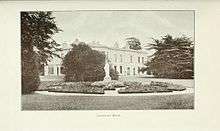Waterville, Dublin
Waterville (Irish: An Coireán) is a modern housing development that forms a remote suburb of Dublin city in the county of Fingal in Ireland. The developments were built between 2002 - 2008 on the edge of the Abbotstown demense on the boundary between Blanchardstown and Castleknock.[1]
History
The area was developed by Granbrind Ltd on land acquired from the Eastern Health Board. The land was previously owned successively by the Barons of Castleknock, Baronets of Abbotstown and Barons Holmpatrick. Historically these lands formed the principal seat in the civil parish and barony of Castleknock.[2]
Waterville is located on the southern edge of the Abbotstown Demense which remained in the ownership of the Tyrell family up to about 1400 when Thomas Sergent and his wife Joan Tyrell, sister to the last Tyrell Baron of Castleknock, where in residence. By the 17th century they had passed to the Sir John Dungan who owned one thatched house, several cottages and an old church at Abbotstown. Later, the lands at Abbotstown were owned by the Clements family, ancestors to the Earls of Leitrim and famous for the fact that one of their number was Nathaniel Clements, Chief Ranger in the Phoenix Park where his residence later became the official residence of the President of Ireland, Áras an Uachtaráin.[3]
The most famous family to live on the lands at Waterville were the Falkiner family who became Baronets of Abbotstown in 1812. The Falkiners married into the Hamilton family who lived on the neighbouring estate of Sheephill and in 1832 both estates where amalgamated by the Hamiltons and a new residence, Abbotstown House, was built as the family seat.

Ion Trant Hamilton was ennobled by Queen Victoria as Baron HolmPatrick and Abbotstown House remained the seat of the Barons until 1947 when James Hans Hamilton, 3rd Baron HolmPatrick (1928–1991) lost part of his lands under a Compulsory Purchase Order to allow for the building of James Connolly Memorial Hospital. Later, Lord HolmPatrick sold remaining lands at Abbotstown to the Marine Institute of Ireland who were located at Abbotstown House until 2005 when the house was acquired for Sports Campus Ireland.[4] In the late 1990s half of the lands under the ownership of the health board were sold for development in order to finance the redevelopment of the hospital buildings.[5]
Location and Name
The development of 1500 homes at Abbotstown was called Waterville due to its proximity to the River Tolka. Waterville lies on the northern banks of the Tolka covering about 50 acres of land.

It is bordered in the South by the Navan Road (N3), on the west by the Snugborough Road, in the north by Abbotstown Farm and to the east by Connolly Hospital. Waterville is approx. 9 km from Dublin City Centre, 2.5 km from Castleknock Train Station and 2 km from Blanchardstown Village. It is adjacent to the National Aquatic Centre, Connolly Hospital and 3 km from the Blanchardstown Shopping Centre. Waterville is 4.5 km from the Phoenix Park.
It comprises thirteen distinct developments and a 25-acre park containing two tiered lakes.[6] Each area within Waterville is privately owned and managed, and each is named after an Irish coastal promontory or island, as follows:
- Brandon Square
- Tory Square
- Blasket Square
- Annagh Court
- Skelligs Court
- Aran Court
- Garnish Square
- Dursey Row
- Bantry Square
- Erris Square
- Achill Square
- Kylmore Terrace
- Rossann Court
Many of the developments in Waterville are built around a central green, while the overall development was built in an integrated fashion merging with the established forestry and parklands.
Access and Public Transport
Situated adjacent to the N3 and the M50, Waterville is only nine kilometres from the city centre, and has excellent access to the entire national roads network. By the end of 2010 the link roads connecting to the new M3 will be completed.
Public transport is very accessible with the following bus routes available:- 38, 38A, 38C, 39, 39X, 70, 70X, 76A, 220, 237, 238, 239 and the 70N Nitelink stop just a short stroll away. The existing Quality Bus Corridor will be complemented by two Metro stations at the proposed Sports Campus Ireland. With close proximity to Waterville and Castleknock train stations, providing a train service via Ashtown, Cabra, Drumcondra to Connolly Station and Busaras (Central Bus Station).
References
- ↑ Rocque Map of Castleknock, 1762.
- ↑ See Map for Fingal County Development Plan 1999- Variation No. 31 (Lands at James Connolly Memorial Hospital)
- ↑ Lacey, J. 1999. A Candle in the Window: A History of the Barony of Castleknock. Dublin. Marino Books. p. 84
- ↑ Lacey, J. 1999. A Candle in the Window: A History of the Barony of Castleknock. Dublin. Marino Books. p. 84.
- ↑ Fingal Development Plan. 1999.
- ↑ Comhairle Contae Fhine Gall, Minutes of Council Meeting CMB/62/06 WATERVILLE PARK 2 March 2006.
External links
- Waterville - Developer's Website
- Bright and Spacious - Independent article from 17 October 2008
- Big Splash - Independent article from 13 March 2009
- National Aquatic Centre
- Castleknock Railway Station